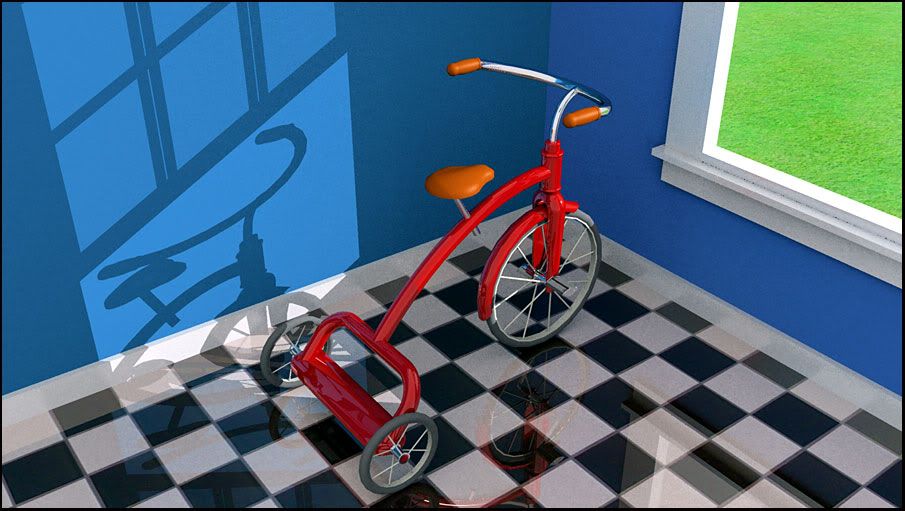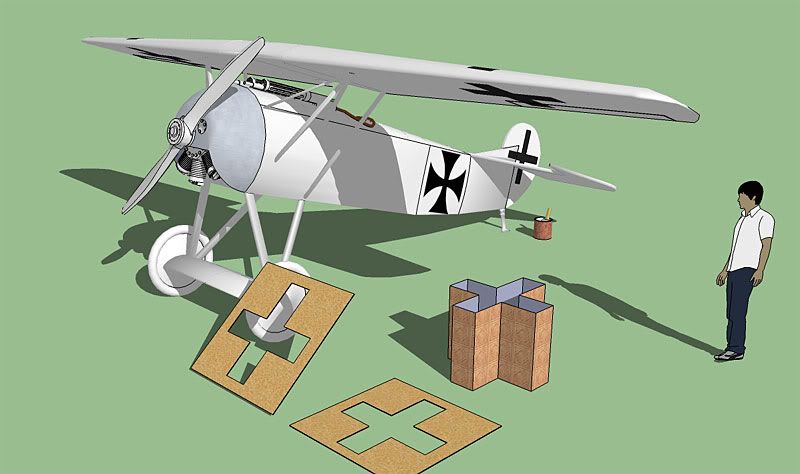Looks like you've got some things figured out about applyling plugins to modeling. I hope you will expand a bit on what tools you've used and what proved useful. I've gotten some smooth results on a similar project recently using Curviloft and Extrude Edges by Rails, but still have a lot to learn about the plugins.
Latest posts made by MichaelG
-
WIP Stunt Plane WIP...............
-
My trike in shaderlight

Shaderlight provides a great user experience for a newcomer to computer graphics like me. Gives me another reason to stick with SketchUp.
-
RE: Looking ahead to SU 8.
Thanks for that link; I hadn't seen that before. The simple scene viewer was pretty much what I had in mind, though there are obviously a lot of other possibilities.
-
RE: Looking ahead to SU 8.
I'd like to see some attention paid to the presentation of SketchUp models in 3D space. While I admire the skills needed to present photo-realistic renderings, the viewing and manipulation of the full model in 3D is really what most interests me. While the program can be freely downloaded for this purpose, I think the products of it could be presented on the web much more effectively with the proper interface. I'm thinking of something along the lines of the little 3D widget used to show models in the Warehouse. Since Google Earth already makes use of a similar interface, it doesn't seem like it would be all that difficult for Google to develop a 3D viewer with considerably more capabilities than the small one now in use.
-
RE: My Airplane
@numbthumb said:
...I have attached the .pdf file. It may come in handy even if you decide to build a rubber band powered Fokker

And if you´re willing to spend a few bucks, there are some good plans here http://unclewilliesplans.com/about4.html
Cheers!Yep,those are the plans I used. The photos of the plane in flight look quite a bit better than the plan version.
I'll check out the other site. If I'm going to spend several weeks on a project, a few bucks for some good plans seems like a good investment. I was laughing this morning at the fact that I just spent $600 on a pc to run a free program.
-
RE: My Airplane
Progress to date.

A measure of my ignorance about SketchUp is how often I am surprised at what is going to be hard and what is going to be easy. The camouflage was pretty much paint-by-the-numbers. Putting a simple line design on the wheel covers turned out to be a challenge which I won't get to until I'm back from a trip to Arizona.
-
RE: My Airplane
@numbthumb said:
Hi, it´s coming out really nice.
Since you´re using SU 7, you can set your default image editor via Window>Preferences>Applications and browse for your .exe file ( Photoshop, Gimp, or whatever your choice is ). This way you can edit your textures in an external application.
To edit your texture, just right click on it and select Edit Texture Image from the Context menu - and your image editor will open. Now any editing you make there, will be instantly applied on your texture when you save your work in your image editor.
Note however that you should make your texture unique before any editing can be done.
Here is an example - a quick lozenge scheme - just an eyeballing ( done in Photoshop )
Hope you can find this useful.
Cheers!Wow, that's good stuff! Many thanks; I'll give it a go.
The criticism from hobnobb also proved very useful. I went back and found I could just scale back the length of the nose by about a third, which made it look quite a bit more like some of the photos of the plane.
-
RE: My Airplane
@hobbnob said:
This looks absolutely amazing so far mate, I'm more of a ww2 person to be honest, but this is a brilliant model. IMO the fuselage looks a bit 'fat' I think, I had a look at the plans but i'm not quite sure tbh.
You are probably right on the "fat". The scale model plan I mostly relied on had some other obvious errors in the wing height and the tail section profile. I have some excellent plans for WWII planes, but I still haven't figured out how to do aspects of any of them properly with SketchUp. The areas I always seem to encounter problems in are the transitions around the cockpit, and the wing fairings. I've worked through a few other issues with this Fokker, and once I've finished with some color and rendering I'll take another whack at a more modern craft.
I've put the unadorned version of the Fokker D.VIII in the Warehouse.
-
RE: My Airplane
I spent the better part of a day figuring out how to put some appropriate national markings on my Fokker.

The vertical stabilizer was relatively easy as it has a flat surface. I was able to just draw the small cross and paint it in.
The maltese cross on the fuselage was done with the technique illustrated in Aidan Chopra's video tutorial for projecting images on curved surfaces.
The crosses on the wings were a more difficult challenge as the curved surface has no demarcated area that would confine a texture. I ended up using the tool illustrated here. Pushing it up through the wing also had the virtue of giving me an identical pattern on both top and bottom surfaces.
I'll start soon to add some color to the model. I don't think I'm up to doing the complicated tiled camo pattern that was most used on the D.VIII. Maybe I'll poke around in the Warehouse to see if I can find any old bolts of fabric.
-
RE: My Airplane
@numbthumb said:
...maybe you´ll find this useful - detailed Spandau machine gun drawings ( for some masochistic work
 ) http://www.finemodelworks.com/arizona-models/reference/Thumbs/Aircraft_Fittings/Machine_Guns/Machine_Guns.html and some D VII drawings http://www.finemodelworks.com/arizona-models/reference/Thumbs/Aircraft/Germany/Fokker/D7/D7.html
) http://www.finemodelworks.com/arizona-models/reference/Thumbs/Aircraft_Fittings/Machine_Guns/Machine_Guns.html and some D VII drawings http://www.finemodelworks.com/arizona-models/reference/Thumbs/Aircraft/Germany/Fokker/D7/D7.html
Cheers!Thanks for those excellent links. It's a great help to have good plans in order to get off to a good start. I've often fooled myself in the past with the idea that I could just wing it, but a little thought and preparation usually means I can get a better result in less time than going the quick and sloppy route.
My Fokker won't impress my aviation history friends, but I was happy that I was finally able to figure out how to punch neat holes in curved surfaces, which turns out to be a big part of aircraft modeling.